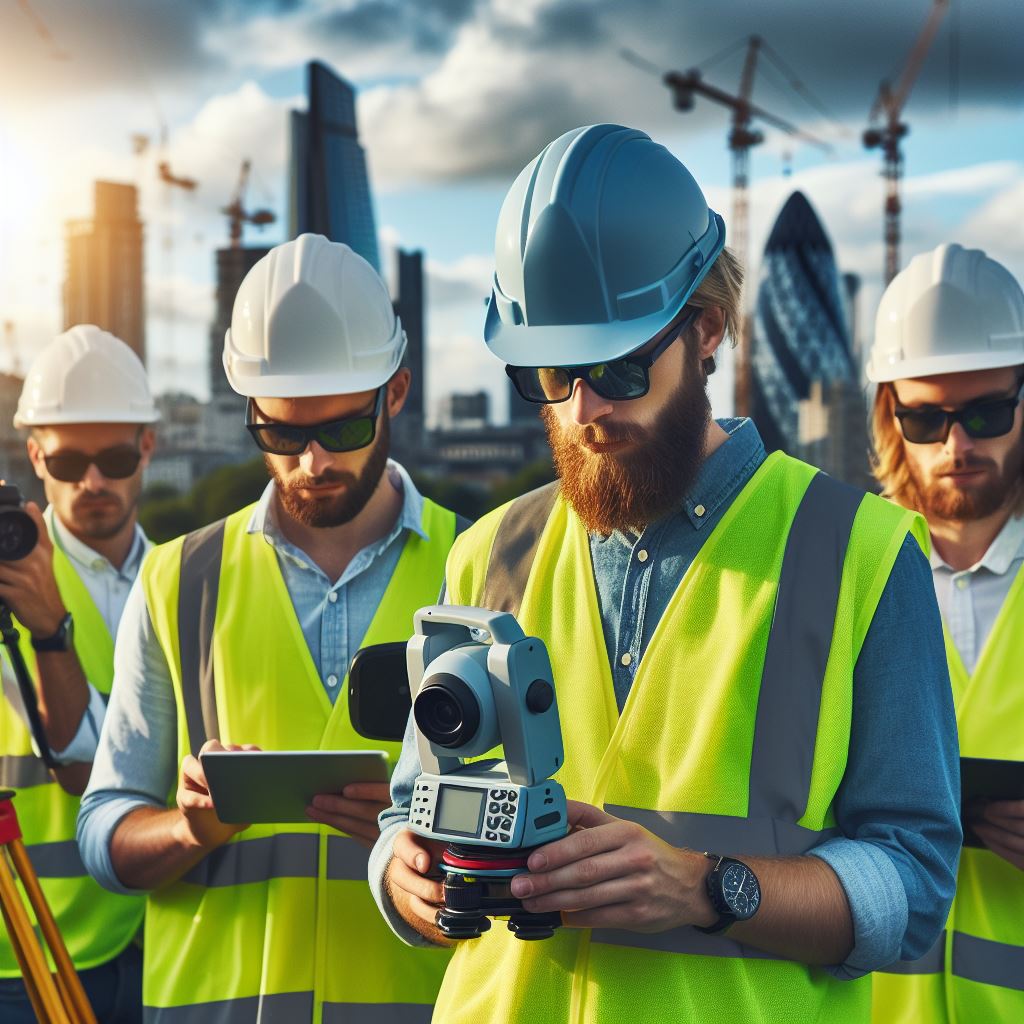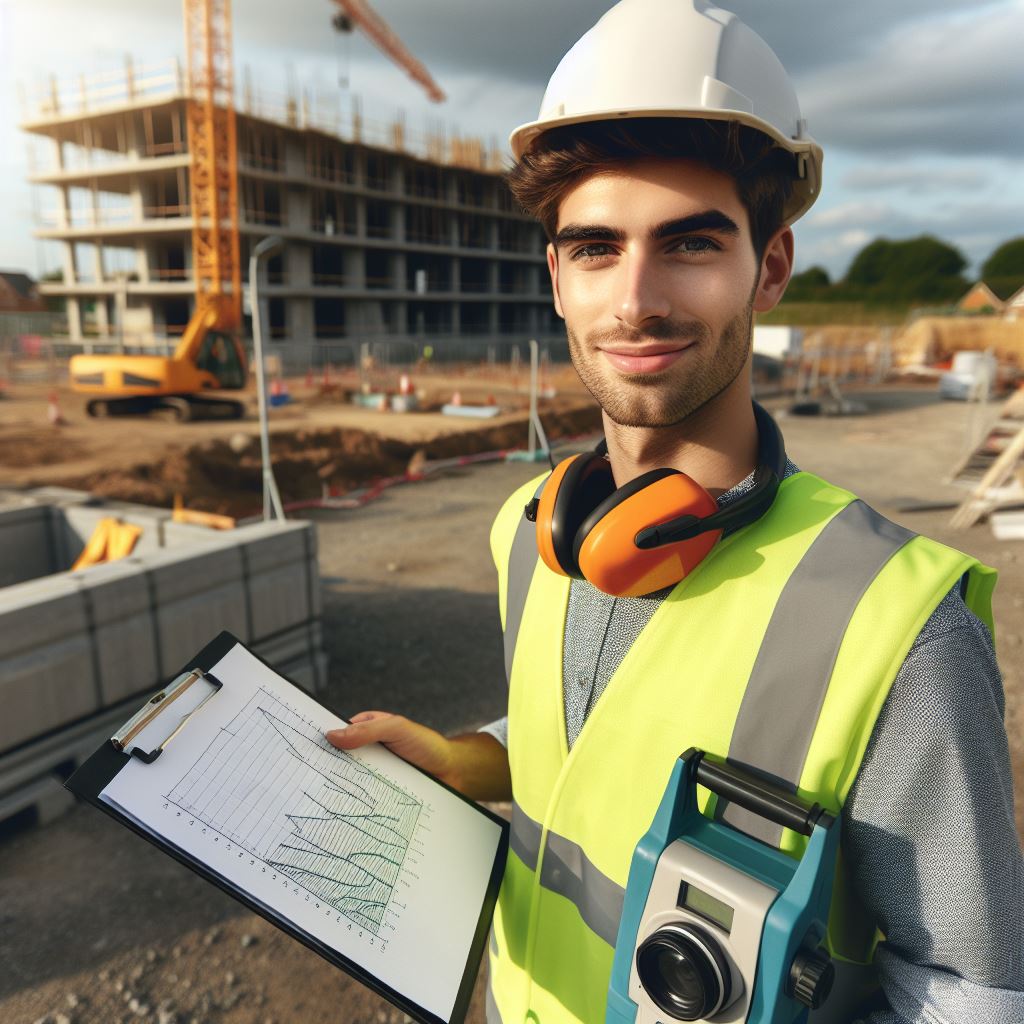Introduction
Surveying is a vital profession in the UK, encompassing various industries such as construction, engineering, and land management.
It involves the measurement and mapping of land, as well as providing accurate data for decision-making processes.
In recent years, the importance of technology in surveying has significantly increased.
Advancements in technology have revolutionized the way surveyors collect, analyze, and present data.
Advanced tools such as GPS, laser scanners, and drones have allowed for more precise measurements, faster data collection, and improved accuracy.
The introduction of technology has also streamlined the surveying process, reducing costs and increasing efficiency.
Surveyors can now gather data remotely, minimizing the need for on-site visits.
Furthermore, data can be processed and analyzed using software, enabling surveyors to easily create detailed reports and visual representations.
The purpose of this blog post is to delve into the various ways technology has transformed the surveying profession in the UK.
It will explore the benefits of using technology in terms of accuracy, efficiency, and cost-effectiveness.
Additionally, it will discuss the challenges associated with implementing new technology and the skills required to adapt to these changes.
In essence, technology has become an essential component in modern surveying practices in the UK.
By embracing technological advancements, surveyors can enhance their capabilities and provide more accurate and reliable data to support decision-making processes in various industries.
Traditional Methods of Surveying in the UK
Brief explanation of traditional surveying techniques
- Traditional surveying involves using physical measurements to determine the size, shape, and boundaries of land.
- Surveyors rely on various techniques such as triangulation, traversing, and leveling to collect accurate data.
- These methods have been used for centuries and have been the foundation of surveying in the UK.
Use of manual tools and equipment
- Surveyors in the UK traditionally use a range of manual tools and equipment for their work.
- These tools include chains, theodolites, compasses, levels, ranging rods, and plumb bobs.
- They require skilled operators and are often time-consuming to set up and use.
- Surveyors use these tools to measure distances, angles, elevations, and other important data.
Limitations and challenges faced by surveyors
- Traditional surveying methods are labor-intensive and can be prone to human errors.
- They also rely heavily on line of sight, making it challenging to survey difficult terrains or obstructed areas.
- Weather conditions like fog or rain can further hinder accurate measurements.
- Manual calculations are required, which can be time-consuming and increase the chances of errors.
- Traditional surveying techniques can be slower compared to modern methods.
In general, traditional surveying methods have been the backbone of land measurement in the UK for centuries.
These methods involve physical measurements and the use of various manual tools and equipment.
However, they have certain limitations and challenges, including human errors, line of sight dependency, and time-consuming calculations.
As technology has advanced, modern methods that rely on digital instruments and computer-aided design (CAD) have gained popularity, revolutionizing the surveying industry in the UK.
Read: Graduate Paths in UK Civil Engineering
Emergence of Technology in Surveying
Introduction of electronic distance measurement (EDM)
Electronic distance measurement (EDM) is a technology that revolutionized the field of surveying.
It has replaced the traditional method of measuring distances manually and brought about numerous benefits.
Benefits of using EDM over traditional methods
- Increased Accuracy: EDM enables surveyors to measure distances with a much higher level of precision compared to traditional methods.
- Time Efficiency: With EDM, measurements can be taken quickly, saving valuable time during surveying projects.
- Reduced Labor: The use of EDM eliminates the need for manual measurements, reducing the amount of physical labor required.
- Improved Safety: Surveyors no longer need to access dangerous or hard-to-reach areas, minimizing the risk of accidents.
- Data Collection: EDM devices allow for the direct collection of measurements, eliminating the need for manual recording and potential errors.
Advancements in total stations and GPS technology
In addition to EDM, advancements in total stations and GPS technology have further enhanced the capabilities of surveying in the UK.
Total stations combine the functionality of an EDM with a theodolite, allowing surveyors to measure both distances and angles simultaneously.
This integration streamlines the surveying process and provides more accurate data.
GPS technology, which utilizes satellites to pinpoint locations, has become an invaluable tool for surveyors.
It provides precise positioning data and allows for seamless integration with digital mapping and surveying systems.
The integration of GPS with total stations has significantly improved the accuracy and efficiency of surveying projects.
Surveyors can now easily locate and measure points in real-time, minimizing errors and reducing the overall project duration.
In fact, the emergence of technology in surveying, such as electronic distance measurement (EDM), total stations, and GPS, has greatly transformed the field in the UK.
These advancements have revolutionized the accuracy, efficiency, and safety of surveying projects, making them essential tools for modern surveyors.
Read: Civil Engineering Licenses in the UK: A Guide
Role of Technology in Various Surveying Applications
Surveying is an essential discipline that plays a critical role in various sectors, including land management, infrastructure development, and environmental conservation.
Over the years, technology has revolutionized the field, enabling surveyors to perform their tasks more efficiently and accurately.
In this section, we will discuss the role of technology in different surveying applications.
Personalized UK Career Consulting
Receive tailored career guidance designed just for you. Get actionable steps and expert support to boost your career in 1-3 days. Take control of your career now.
Get StartedLand surveying
1. Use of GIS software and GPS receivers
Geographic Information System (GIS) software allows surveyors to manage and analyze geographic data, facilitating precision in land surveying.
Coupled with GPS receivers, which provide accurate positioning information, surveyors can determine precise coordinates within a short period.
2. Digital mapping and data collection tools
Digital mapping tools have replaced traditional paper maps, making it easier to visualize and interpret geographical features.
Additionally, surveyors can use data collection tools, such as field tablets or mobile apps, to record and store measurements directly in a digital format, eliminating the need for manual data entry.
Construction surveying
1. Building Information Modeling (BIM)
Building Information Modeling (BIM) is a powerful technology that allows surveyors to create digital 3D models of buildings and infrastructure projects.
By integrating various data sources, including survey measurements, architects, engineers, and contractors can collaborate and ensure accurate planning, clash detection, and design optimization.
2. 3D laser scanning for precise measurements
Laser scanning technology enables surveyors to capture millions of data points quickly and accurately.
By emitting laser beams and measuring the reflected light, surveyors can create highly detailed 3D representations of existing structures, capturing intricate features and providing precise measurements for renovation or construction projects.
Hydrographic surveying
1. Sonar technology and bathymetry
In hydrographic surveying, sonar technology plays a crucial role in mapping underwater terrains.
By emitting sound waves and measuring their reflections, surveyors can determine water depths and create accurate depth charts.
Bathymetry, which involves measuring the depth and shape of underwater surfaces, complements sonar technology in providing comprehensive underwater maps.
2. Remote sensing for mapping water bodies
Remote sensing techniques, such as satellite and aerial imagery, are employed to capture data for mapping and monitoring water bodies.
By analyzing different wavelengths of light, surveyors can identify and monitor water quality, detect changes in aquatic vegetation, analyze sedimentation patterns, and assess the health of aquatic ecosystems.
Technology has significantly enhanced the capabilities of surveyors in various applications.
From land surveying to construction and hydrographic surveying, the use of GIS software, GPS receivers, digital mapping tools, 3D laser scanning, sonar technology, and remote sensing has revolutionized the accuracy and efficiency of surveying practices.
It is evident that embracing technological advancements is vital for modern surveying professionals to thrive and deliver precise results in an increasingly complex and dynamic environment.
Read: UK Civil Engineering: Historical Impact

Impact of Technology on Surveying Profession in the UK
Increased efficiency and accuracy in data collection
The use of technology in surveying has greatly improved the efficiency and accuracy of data collection.
Surveyors now have access to advanced tools such as laser scanners and drones, which can quickly and accurately capture data.
These technological advancements have eliminated the need for manual measurements and reduced the chances of human error.
Streamlined workflows and reduced time spent on surveying tasks
Technology has significantly streamlined workflows in the surveying profession, saving surveyors a significant amount of time.
With the use of digital tools, surveyors can now easily collect, process, and analyze data in real-time.
They no longer have to spend hours manually inputting data or waiting for physical measurements to be processed.
Cost savings and improved project management
The adoption of technology in surveying has resulted in substantial cost savings for businesses and clients.
Your Dream Job Starts with a Perfect CV
Get a tailored CV and cover letter that captures your unique strengths and stands out in your industry. Let us help you make an unforgettable first impression.
Get StartedBy reducing the time spent on surveying tasks and increasing efficiency, companies can complete projects faster and at a lower cost.
The use of digital tools allows for better project management, enabling surveyors to track progress and make necessary adjustments in real-time.
Enhancing surveyors’ capabilities and expanding job opportunities
Technology has expanded surveyors’ capabilities, allowing them to take on more complex projects and deliver higher-quality results.
Advanced software and equipment have enabled surveyors to perform tasks that were previously impossible or time-consuming.
For example, with 3D laser scanning, surveyors can now create detailed 3D models of building interiors, facilitating better planning and design.
Moreover, the integration of technologies like virtual reality and augmented reality has opened up new job opportunities for surveyors in fields such as gaming and simulation.
In short, the impact of technology on the surveying profession in the UK has been overwhelmingly positive.
From increased efficiency and accuracy in data collection to streamlined workflows and cost savings, technology has revolutionized the way surveyors work.
Technology has enhanced their capabilities and expanded their job opportunities, paving the way for a more advanced and dynamic surveying industry.
Read: Networking for Civil Engineers in the UK
Challenges and Future Trends in Technology-Driven Surveying
Integration of new technologies into existing workflows
As the role of technology evolves in modern UK surveying, several challenges and future trends emerge.
Integrating new technologies into existing workflows is vital for surveying firms to stay competitive.
The restructuring of processes may be necessary to accommodate the use of advanced surveying tools effectively.
Transitioning to new technology requires significant investment in equipment, software, and training for surveyors.
Training and upskilling surveyors to utilize advanced tools
Training and upskilling programs play a crucial role in ensuring surveyors can effectively utilize advanced tools.
Comprehensive training allows surveyors to understand the operation and benefits of technology-driven surveying equipment.
Continuous learning and professional development are essential to stay updated with the latest technological advancements.
With proper training, surveyors can harness the full potential of technology and deliver high-quality results.
Adoption of artificial intelligence and automation in surveying
The adoption of artificial intelligence and automation presents significant opportunities in surveying.
AI algorithms can automate data processing and analysis, reducing human errors and saving time.
Automated surveying tools powered by AI can streamline repetitive tasks and enhance productivity.
Machine learning algorithms can improve the accuracy and reliability of survey results.
The successful adoption of AI and automation requires the development of robust algorithms and sophisticated software solutions.
Potential limitations and ethical considerations
While technology-driven surveying offers numerous benefits, it also raises potential limitations and ethical considerations.
Data privacy and security concerns arise as more sensitive information is collected and processed.
Increased reliance on technology may reduce human involvement and decision-making, potentially leading to challenges in accountability.
Ethical considerations surround the responsibility for inaccuracies or biases in automated surveying systems.
Maintaining transparency and addressing these ethical concerns are crucial for responsible use of technology in surveying.
Optimize Your LinkedIn for Success
Boost your LinkedIn profile with a professional bio, keyword-rich headline, and strategic recommendations that attract recruiters. Stand out from the crowd and get noticed.
Optimize NowIn review, the integration of new technologies, training and upskilling of surveyors, adoption of artificial intelligence and automation, and addressing potential limitations and ethical considerations are critical aspects of technology-driven surveying in the UK.
Embracing these challenges and future trends will enable surveyors to harness the full potential of technology and revolutionize the field of surveying.
Conclusion
Recap of the role of technology in modern UK surveying
In this section, we have explored the significant role that technology plays in modern UK surveying.
From advanced mapping tools to 3D scanning and drones, technology has revolutionized the way surveyors work.
Importance of staying updated and embracing technological advancements in the profession
It is crucial for surveying professionals to stay updated with the latest technological advancements in their field.
Embracing new tools and software can enhance efficiency, accuracy, and productivity in surveying projects.
Encouragement for readers to explore further resources and stay informed about technology in surveying
To truly benefit from technology, it is essential for surveyors to keep learning and exploring new resources.
By attending conferences, workshops, and webinars, surveying professionals can stay informed about the latest trends and advancements in their industry.
By embracing technology, surveyors can streamline their processes, deliver higher quality results, and stay ahead of the competition.
We hope this section has provided valuable insights into the role of technology in modern UK surveying.
By being proactive and embracing technology, surveying professionals can unlock new opportunities and achieve greater success in their careers.
For further reading and resources, we encourage our readers to explore industry publications, online forums, and specialized websites dedicated to technology in surveying.
[E-Book for Sale]
500 Cutting-Edge Tech Startup Ideas for 2024 & 2025: Innovate, Create, Dominate
$19.99 • 500 Tech Startup Ideas • 62 pages
You will get inspired with 500 innovative tech startup ideas for 2024 and 2025, complete with concise descriptions to help you kickstart your entrepreneurial journey in AI, Blockchain, IoT, Fintech, and AR/VR.




